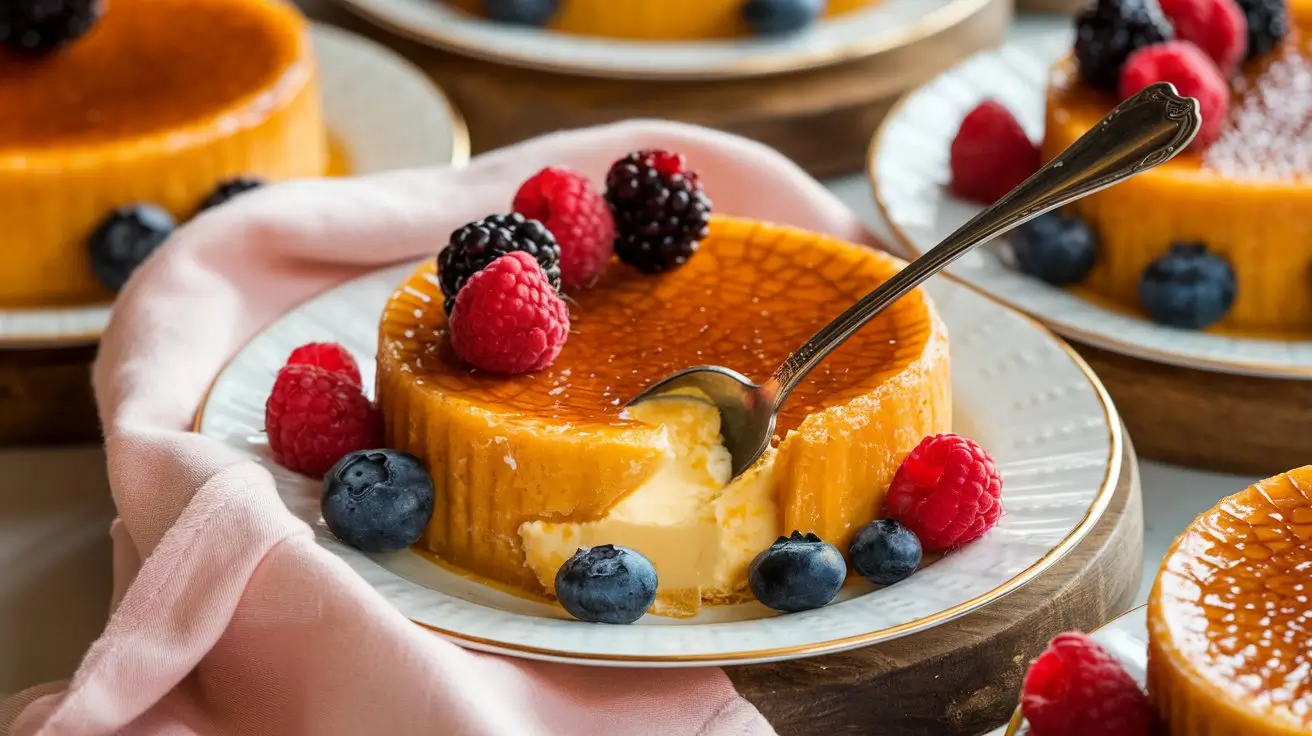Crème brûlée is the epitome of elegance in the dessert world. With its silky-smooth custard and crisp caramelized sugar topping, it strikes the perfect balance between creamy indulgence and delicate crunch. But what is the secret to crème brûlée?
The answer lies in a combination of factors, the right ingredients, precise techniques, and a little bit of patience. From selecting the best cream and eggs to mastering the art of caramelization, every step plays a crucial role in achieving that luxurious texture and signature crackly top.
In this guide, we’ll break down everything you need to know, from the fundamental ingredients to the most common mistakes to avoid. Whether you’re a seasoned baker or a home cook attempting this classic French dessert for the first time, this article will help you uncover the secrets to a flawless crème brûlée.
Table of Contents
Introduction
What is Crème Brûlée?
Crème brûlée, meaning “burnt cream” in French, is one of the most iconic French desserts. It consists of a smooth, rich custard topped with a caramelized sugar crust. But what is the secret to crème brûlée? It’s all about achieving the perfect balance of textures and flavors.
The History and Origin of Crème Brûlée
Although crème brûlée is widely associated with French cuisine, its origins are debated. Some historians trace it to Catalan cuisine (crema catalana), while others believe it was first made in England as “burnt cream” at Trinity College, Cambridge.
No matter its origin, crème brûlée remains a luxurious dessert that has stood the test of time. But what is the secret to crème brûlée? It’s not just the ingredients, but also the technique used to achieve its signature texture.
Why is Crème Brûlée So Popular?
This dessert has been a culinary favorite for centuries, and for good reason:
✔ Few ingredients, luxurious flavor – Simple pantry staples create an unforgettable experience.
✔ Contrast of textures – Silky custard meets a crisp caramelized top.
✔ Elegant yet simple – Looks like a gourmet masterpiece, yet it’s easy to make.
In the next section, we’ll dive into the key ingredients that make this dessert truly special and how they affect the final result.
The Key Ingredients for a Perfect Crème Brûlée
Heavy Cream: The Foundation of Smooth Custard
The foundation of crème brûlée’s silky texture is heavy cream. It provides the dessert’s signature richness, ensuring a custard that is lusciously smooth. Using full-fat heavy cream (at least 36% fat) is crucial, lower-fat alternatives like milk or half-and-half can result in a thinner, less decadent texture.
For a deeper flavor, some chefs infuse the cream with vanilla beans or citrus zest. To do this, heat the cream with a split vanilla bean and let it steep before straining. What is the secret to crème brûlée? Many experts say it’s the quality of the cream, as it directly affects texture and taste.
Egg Yolks: Achieving the Right Texture
Egg yolks are what give crème brûlée its luxurious custard-like consistency. They act as a thickening agent, binding the ingredients together when baked. A common mistake is using too many yolks, which can make the custard overly firm. The ideal ratio? One egg yolk per ½ cup of cream.
When mixing yolks with sugar, avoid overwhisking. Too much air can create unwanted bubbles, leading to an uneven texture. What is the secret to crème brûlée? Gentle mixing and low baking temperatures ensure a perfectly smooth custard.
Sugar: The Role of Sweetness and Caramelization
Sugar plays two important roles in crème brûlée:
- Sweetening the custard – Use superfine sugar for easier blending.
- Creating the caramelized top – The key to a crisp, crackable sugar crust.
For the topping, white granulated sugar is the best choice. It caramelizes evenly and quickly under a torch, giving that signature glass-like finish. Brown sugar may seem tempting, but it contains moisture, which can result in a sticky, uneven layer.
Vanilla and Other Flavor Enhancements
Traditional crème brûlée is infused with vanilla, but there’s room for creativity. Consider these variations:
- Vanilla bean – For an intense, authentic flavor.
- Espresso or chocolate – A rich, indulgent twist.
- Citrus zest or liqueurs – Adds brightness and complexity.
By carefully selecting ingredients, you’re already halfway to unlocking the secret to crème brûlée. But mastering the technique is just as important, let’s explore that next.
The Secret Technique Behind a Perfect Crème Brûlée
Achieving the Right Custard Consistency
One of the biggest mistakes in making crème brûlée is overheating the custard mixture. The goal is to cook it gently, so it sets into a smooth, creamy texture without curdling.
The best approach? Low and slow baking.
- Preheat your oven to 300°F (150°C).
- Pour the custard into shallow ramekins for even cooking.
- Bake until the center is slightly jiggly but set, about 30-40 minutes.
If the custard is too firm, it’s overbaked. If it’s runny, it needs more time.
The Role of Temperature Control
What is the secret to crème brûlée? Temperature control is a major factor. Custard is delicate, and sudden temperature changes can lead to cracking or graininess.
To avoid this:
- Cool gradually – Let the custard rest at room temperature before refrigerating.
- Chill properly – Refrigerate for at least 4 hours (preferably overnight) before caramelizing the sugar. This allows the custard to fully set.
The Importance of a Water Bath (Bain-Marie)
Baking crème brûlée in a bain-marie (water bath) ensures even heat distribution, preventing curdling or overcooking.
Here’s how to set one up:
- Place the ramekins in a deep baking dish.
- Fill the dish with hot water, reaching halfway up the ramekins.
- Bake gently, ensuring the water doesn’t boil.
This method creates gentle, even heat, leading to the silkiest custard imaginable.
Avoiding Common Custard Mistakes
Even small mistakes can ruin the final texture. Avoid these common pitfalls:
❌ Overmixing eggs and sugar – Can create foam, leading to an airy, uneven custard.
❌ Skipping the water bath – Results in rubbery, unevenly cooked custard.
❌ Rushing the chilling step – Leads to a soft or runny dessert.
By following these steps, you’re mastering the true secret to crème brûlée! Up next, we’ll uncover the art of the caramelized top and how to achieve that perfect crunch.
The Art of the Crème Brûlée Caramelized Top
Choosing the Best Sugar for Caramelization
One of the biggest secrets to a perfect crème brûlée is choosing the right sugar for caramelization. But what is the secret to crème brûlée when it comes to its famous crunchy top?
For even caramelization, use superfine granulated sugar. It melts smoothly and creates that iconic golden crust. While brown sugar might seem tempting, its moisture content can lead to a sticky, uneven texture.
How to Properly Torch Crème Brûlée
Using a kitchen torch is the best way to create a glassy, evenly caramelized top. Here’s how to do it:
🔥 Sprinkle a thin, even layer of sugar over the custard.
🔥 Hold the torch 2-3 inches away and move it in circular motions.
🔥 Let the sugar cool for 1-2 minutes before serving for the perfect snap.
If you’re using a broiler instead of a torch, be sure to place the ramekins as close as possible to the heat and watch them carefully to avoid burning.
Common Mistakes to Avoid When Making Crème Brûlée
Many home bakers wonder, what is the secret to crème brûlée? The real secret is avoiding these common mistakes that can ruin its smooth texture and signature caramelized topping.
Overcooking or Undercooking the Custard
Crème brûlée should be set but slightly jiggly in the center when baked. If it’s too firm, it’s overcooked; if it’s too runny, it needs more time. To ensure perfect consistency:
✅ Bake at 300°F (150°C) for 30-40 minutes.
✅ Always use a bain-marie (water bath) for even cooking.
Why Your Crème Brûlée Might Be Grainy
If your custard turns out grainy or curdled, the egg yolks were likely cooked too fast. What is the secret to crème brûlée? Gentle heat! Always:
✔ Heat cream slowly before adding it to egg yolks.
✔ Temper the eggs by adding warm cream gradually.
Variations and Unique Twists on Crème Brûlée
While the classic vanilla version is beloved worldwide, many creative twists can elevate this dessert. From chocolate-infused custards to dairy-free options, let’s explore some exciting variations of crème brûlée.
Chocolate, Coffee, and Other Flavor Variations
If you’re a chocolate lover, consider swapping a portion of the heavy cream with melted dark chocolate. This creates a decadent, silky-smooth chocolate crème brûlée that pairs beautifully with fresh berries.
For coffee enthusiasts, adding espresso or coffee liqueur can give the custard a bold, sophisticated twist. Here are a few more fun variations:
- Matcha crème brûlée – A delicate green tea flavor with a vibrant color.
- Pumpkin spice crème brûlée – A seasonal favorite, perfect for fall.
- Salted caramel crème brûlée – A combination of rich custard with a hint of salted caramel.
Dairy-Free and Vegan Alternatives
Traditional crème brûlée relies on heavy cream and egg yolks, but that doesn’t mean dairy-free eaters have to miss out!
Here’s how to create a vegan crème brûlée:
- Replace heavy cream with full-fat coconut milk for a creamy base.
- Use cornstarch or agar-agar as a thickener instead of eggs.
- Swap white sugar for maple syrup or coconut sugar for a natural touch.
Even without dairy, this version retains that smooth, rich texture that makes crème brûlée irresistible.
Modern Twists: Infused and Alcohol-Based Crème Brûlée
For a more grown-up version, infuse the custard with liqueurs such as:
- Grand Marnier (for a citrusy kick)
- Amaretto (for a nutty depth)
- Baileys Irish Cream (for a smooth, boozy twist)
These additions enhance the dessert’s flavor while keeping its luxurious feel. Whether you prefer classic or bold, there’s always room to get creative with crème brûlée!
FAQs
Over the years, home bakers and chefs alike have asked what is the secret to crème brûlée? Below, we’ll answer some of the most common questions about making this timeless dessert.
What not to do when making crème brûlée?
Making crème brûlée may seem simple, but a few mistakes can ruin its texture:
❌ Overheating the cream – If the cream is too hot, it can scramble the eggs. Always let it cool slightly before mixing.
❌ Skipping the water bath – This leads to rubbery, uneven custard. Always bake in a bain-marie.
❌ Using the wrong sugar for caramelization – Brown sugar can be too moist, leading to a sticky, uneven topping. Stick to granulated sugar for the best crunch.
What is the secret to crème brûlée? A perfect balance of technique, quality ingredients, and patience!
How to get the perfect crème brûlée top?
The secret to a crisp, even caramelized top lies in sugar distribution and torch technique:
🔥 Use superfine white sugar – It melts and caramelizes faster.
🔥 Hold the torch at an angle – This prevents burning and creates an even glaze.
🔥 Caramelize in layers – Torch a thin layer of sugar, let it cool, then repeat for a perfect crunch.
What is the best sugar to use on crème brûlée?
White granulated sugar is the best choice because of its fine texture and even melting properties. If you want a deeper caramelized flavor, try turbinado or demerara sugar.
How to remove bubbles from crème brûlée?
Bubbles in the custard can affect the texture, but here’s how to fix them:
- Strain the custard through a fine-mesh sieve before pouring it into ramekins.
- Tap the ramekins gently to release air bubbles before baking.
- Use a kitchen torch to pop any surface bubbles before baking.
Mastering these little details will ensure you create the perfect crème brûlée every time!

